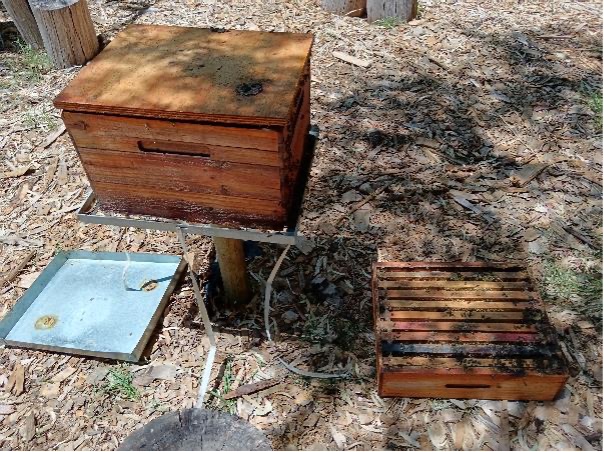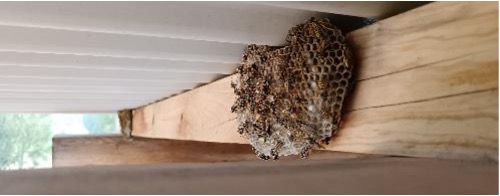
Restaurants
Spa
Day Visits
Shop
Functions
16°C
January 26th, 2024
A week in the life of Babylonstoren’s VIP garden workers, by our resident beekeeper and entomologist, Arné Stander.
It’s been a hot two weeks, with temperatures touching the 40°C mark. We were fortunate to have a maximum of only 32°C at our last bee workshop, which was attended by 11 guests.
• The first stop on our garden tour was the lavender in front of Babel, where we observed carpenter bees. We also spotted a neon cuckoo bee and a few bee mimic flies. Honeybees were foraging on the flowers.
• We moved on to the waterlilies and saw bees visiting the flowers.
• We had a look at the carob trees, where bees were foraging pollen.
• The insect hotel is home to solitary guests at present, who cover certain holes with mud to protect their offspring from potential predators.
• At the observation beehive we could see some capped honey at the top of the frame, with uncapped honey below.
• We got into our bee suits and went to the Soetdoring apiary. While everyone was busy closing their suits, I started with the smoker. As soon as everyone was ready, we went into the camp and had a look at our first hive.
I showed the guests a frame which was about 50% capped with honey. I explained that it needed more time for the bees to cap more of it, before it could be harvested.

We looked at two more hives: the first had more than 90% capped honey and the second was a brood chamber lacking a super. We did not find a queen, but enough brood to show that she is doing an excellent job. The workshop ended with lunch at the Greenhouse and every guest received a perilla (shiso) plant.
Later in the week I returned to the Soetdoring camp to harvest honey. I was able to harvest four supers of honey. A fifth hive is almost ready to give another super of honey. Some frames were 100% capped, which is quite a sight! I worked carefully, especially due to the hot weather. It is important to keep the hives closed when it is hot. I would therefore remove the super from the brood chamber, close the hive with the inner lid, and work through the super, selecting the frames that are harvestable.

Using a small, leafy twig, I gently brush the bees off the frames before adding them to the empty super, which is closed with two outer lids.

After each frame is inserted into the carrying super, the lid is closed. This procedure takes time, but it minimizes the number of worker bees getting trapped inside.

As a frame is harvested, I replace it with new a new one, closing the gaps in the super as I go. This allows the bees to crawl in between the frames and not be exposed.

The frame below is another example of a 100% capped frame. Darker spots in the frame indicate a difference in nectar, as bees do not mix nectars in the same hexagon cells.

The frame below is a side frame in the super and contains a deformed comb. This strange formation is due to the wider gap between the frame and the inner wall of the super. With a larger gap, the bees were able to build wider comb on the frame.

I also harvested honey in the Eucalyptus camp where some hives are closed to encourage more capped honey, as the frames are only around 60%. It was extremely hot. I harvested the frames directly from the super, without taking the super off. I shifted the frames that were still not ready to be harvested to the middle, and placed the new frames on the sides. I closed the hive to keep the bees at ease. Bees from the harvested frames could be brushed off and added to my carrying super.

The photo below shows beautiful, snowy-white capped frames, due to being new frames with new wax sheets. This is the first honey we’ve harvested that displays such white comb.

COMING UP
• I look forward to harvesting more honey soon. I will go through the hives that don’t have supers, as they are still recovering from the badger saga.
• I killed more of the European paper wasp (Polistes dominula) nests this week around the Moestuin, under the main building’s roof, and around farm implements that have been stationary for some time, allowing them to build proper nests.

BEE JARGON
Apiary – Colonies, hives, and other equipment assembled in one location for beekeeping operations.
Beehive – An artificial cavity for a bee colony to live in, usually a box or boxes with movable frames.
Brood – Immature bees that are still inside their cells. Brood can be in the form of eggs, larvae, or pupae of different ages.
Capped honey – When bees cover their honey with wax, much like putting a lid on it.
Hive – A manmade structure used by a colony of bees as a nest cavity.
Queen – A female bee with a fully developed reproductive system. Larger and longer than a worker bee.
Super – Any hive body, usually a smaller box, used for the storage of honey which the beekeeper intends to harvest. Normally it is placed above the brood chamber(s). Supers are typically medium or shallow-sized boxes.